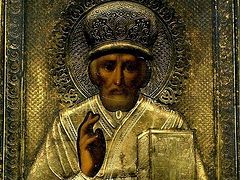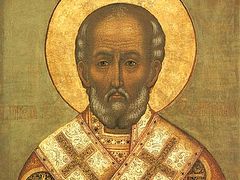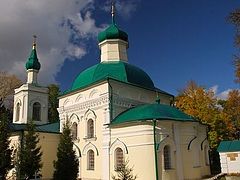The fact that the Lord never abandons those who hope and believe in Him, those who ask the saints for their intercessions, is confirmed by yet another seemingly simple story that happened not too long ago in the 1990s in Tallinn, Estonia. Thanks to the intercessions of St. Nicholas, the church on Vene Street in Tallin continues not only to adorn the city, but also continues to warm its people’s souls, ever in need of such warmth in our difficult day and age. Fr. Oleg Vrona, rector of the Church of St. Nicholas, recounts the following.
Difficult times, insatiable appetites
There was a warm spring wind and I was taking a slow walk around my parish—the St. Nicholas Church in Tallinn—and sadly glanced over at the stone walls, covered with many cracks, and the rusting drains, and the shabby-looking wooden balustrades surrounding the bell towers. There was enough cause for sadness. It was the 90s then, and the main sinful passions of man—vainglory, avarice and lust—were flourishing in full strength, irresistibly compelling some to try their luck at “baiting” in the murky waters of the political turmoil of those days. Oh, if only these passions would have tempted just the nonreligious. But such is not the case!
Many foreign-based religious sects were craftily spreading their nets within our “reservoirs”, as if within their own, in attempt to catch, possibly, not so much the souls of our compatriots, but, rather, their wallets. Furthermore, many of our own “coreligionists” (for example, in Estonia) were successful at “fishing out” for themselves our parish churches, which they did not build, as well as church property, which they never owned, and would “string” like fish a number of our parishioners whom they never cared for.
Appetite, as they say, comes while one is eating, and the same can be said about the thrill that comes to the fisherman while he’s fishing. Also, when one has all the right tools at hand, then, accordingly, the “fish” don’t stand much of a chance. The only bright side for our parishes, which stubbornly preferred faithfulness to the Church over any kind of financially beneficial “bait” (which was persistently being offered up to us), was that they could opt to rent their churches from the government. Or, rather, accept this kind of option as a token of great mercy from the Estonian government officials and the Patriarchate of Constantinople,1 which were dictating conditions to us at the time. Of course, we weren’t just doing nothing ourselves. However, in a time where such “poaching” had become legal, no “fish” could stand a chance—it would be caught sooner or later, as we all knew. And because this “fish hunt” continued on not for months, but for a few years, the more active part of our priesthood, to which I, a sinner, belonged to, would for the most part be forced to spend time defending the parishes that had remained faithful to the Mother Church, instead of spending time and energy on helping out parishioners or carrying out necessary repair work in their own parishes. Our own parishes, however, would still call out to our conscience, for they were in need of renovation and restoration in order to have their former beauty restored. In legal terms they may have no longer belonged to us, but they were no less dear to us than they were before, so we could not help but care for them.
The ordinary cares and troubles of a parish rector
On one warm spring evening I had a thought, as if someone had just placed it in my head: “You need to start repairing the church. You just have to, and that’s that.” It’s worth noting that at that time in Estonia, one of the phenomena of the Soviet era, the “shabashniki” [moonlighting handymen], who for a moderate fee would repair anything and everything you needed, were already nonexistent. Their place was taken by construction companies, and I decided to turn to one which was situated right across from our parish in order to have them survey the church and determine what it would cost to have its facade repaired. The sum, I thought, which the savvy estimators would come up with, would not frighten me, as we didn’t have enough money for any major kind of repairs anyway. But there was small hope that perhaps the company would agree to settle on a phased repair plan, prolonging if necessary the joys of having scaffolding and construction materials all over the place for a more or less longer period of time. However, the savvy team of estimators surpassed my naive hopes, and the final sum in Estonian kroons, which ended in five zeroes, was way above our heads. The only thing left to do now was to kindly ask the owner of the company to pardon the evaluation fee and start searching for a different company with a bit less of a demanding appetite.
In the end such a company was found, and we agreed to have only the bell tower repaired (anything more than that we could not afford). In just a few days’ time the work had begun in full swing, although to outside observers it might have seemed that there was little to no progress, as the company only had two house-painters. Furthermore, they did not wear any special uniforms and worked in regular clothes, so anyone passing by might have thought the parish was just doing the repairs on its own.
A late-night call
As the days went by the scaffolding slowly but surely moved from one side of the bell tower to the other, and we were glad to see such progress. It was now possible to admire the almost completed, freshly painted bell tower. Not long afterwards someone had decided to call me late one evening, which is generally not a very acceptable thing to do at such a time, and not only in Estonia. I picked up the phone and heard a familiar voice: “Hello, Fr. Oleg. It’s Nikolai Vasilevech Solovei”. “Oh, how could I not have recognized you, Nikolai Vasilevech”, I grumbled to myself, having lost hope that I’d hear anything significant. It’s probably going to be another “ingenious” idea, I thought. And I replied: “Hello, Nikolai Vasilevech, how are you?”
Nikolai Vaslilevech Solovei was very famous and well-respected in Estonia—he was one of those restless and enthusiastic social activists that gave no peace of mind to others or to themselves, the kind of activists who, thanks to their vast amounts of energy, would sometimes come up with projects that were much-needed by others, resulting in the formation of a union between the two for many years to come. Nikolai Vasilevech was the founder and head of the Society of Slavic Cultures in Estonia, thanks to which many different cultural events took place in the country each year. Furthermore, he had been elected deputy of the Tallin City Assembly more than once, and happened to be deputy then at that time when he had called me.
Nikolai Vasilevech always had a lot of ideas—it’s just that he couldn’t always explain how he was planning on realizing them. I remember once he invited me to his office and said: “I have a fantastic idea: a school for spiritual education”. I carefully asked him: “And how do you think of realizing such an idea?” Nikolai Vasilevech flared up: “And what’s there to it?! Just get your mind around how great of an idea this is!” In all honesty, I had enough reason to feel pessimistic that evening.
“How much do these Orthodox need?!”
“Today,” continued Nikolai Vasilevech with much enthusiasm, “I had a meeting with the Commission on Culture at the City Assembly. We distributed budget funds to schools, etc. All the Estonian schools received funding, while not a single word was said about Russian schools! So I said to the council members: ‘Let’s give some money to at least one Russian school!’, and I named one of the schools. Unwillingly they obliged. At the end of the meeting they started distributing funds to churches. Funds were given to Lutheran churches, but not a single mention was made of the Russian Orthodox Church. So I said, again: ‘Let’s give money to at least one Russian church’. And explained: ‘for reconstruction’. I told them I was recently passing by the St. Nicholas Church on Vene Street and noticed how the parish had begun reconstructing the church facade on their own. ‘It’s important to note that this particular church, in case anyone isn’t aware, is a state protected architectural monument, and in addition to that, it is situated along a tourist trail—tour groups, I tell you, are all over the place there. Then the Chairman said to me: ‘Well, let’s suppose we give them some of the funds. Now how much would we give?’ Without much thinking, I called out a number. There was lingering. Then one of the council members said: ‘But there’s no quote or cost estimate’. ‘There’ll be one tomorrow’, I answered. So they voted. The proposal was accepted”. “Now tomorrow,” continued Nikolai Vasilevich, “you and I have to head over to the City Hall with a cost estimate in order to get approval for the funds.”
“Well, that’s easy enough to say: ‘with a cost estimate’”, I instantly thought. How are you supposed to get one now?! But then my other hand which was free from the phone for some reason reached for a pile of papers and, you wouldn’t believe it, pulled out a cost estimate. Yes, yes, that very same one, with the unimaginably steep for our parish sum in Estonian kroons with the five zeros at the end. For some reason, I hadn’t thrown it away. I breathed a heavy sigh of relief at first, but then my mood began to plummet again: “Nikolai Vasilevech”, I said, “I’ve got a quote, but the sum is too large”. “How much is it?” he asked. So I gave him the number with the five zeroes. At that moment Nikolai Vasilevech was unable to conceal his surprise: “Well, how about that! That’s the exact same number I gave the council members.” Just imagine: the numbers completely matched up! Now I could feel that my own voice was trembling with excitement: “Nikolai Vasilevech, it’s a miracle. It must have been St. Nicholas. Thank you so much, Nikolai Vasilevich!”. “Oh stop it, father! Don’t thank me, thank St. Nicholas”.
A serious talk with the Patriarch
The next morning we went through all the necessary offices at the City Hall and received approval. That evening I couldn’t resists and shared my joy over the phone with Patriarch Alexei himself (I had the opportunity then to speak with him sometimes). However, having listened to me, he thoughtfully noted that it’s good that they promised the funds, but that I shouldn’t be so sure until I’ve actually received them. His wise words may have somewhat cut down my excitement, but not my faith in the miraculous help of St. Nicholas. And in the end, the city authorities did fulfill their promise and granted us the funds! Having received the funds, we could now repair whatever we wished. Many years have passed since then, but the parish continues to benefit from those repairs to this day.
Also, I cannot help but point out one of the heartwarming details of this story. To be honest, the most important thing for me in this whole story was not the fact that we had miraculously received money from the city officials, and it was not the repair itself either, even though it had transfigured our parish. The main thing, however, about this miracle was that it once again convinced us that the truth was on our side in our endeavors to take a stand for and defend our parish churches. And, as we know, God and His saints are always on the side of truth.
Let’s not be downcast
When facing difficulties it’s possible to grow weak spiritually, fall into despondency and just give up, saying: “Nothing can be done!” Or, on the other hand, we can continue firmly believing in God’s desire and capability of saving us from every form of evil—even the petty, as it may seem, material kind. And this, in my opinion, is the moral of our miraculous yet simple and almost ordinary story, which demonstrates the kind of help we can receive through the intercessions of St. Nicholas. So, to have faith, to turn to Christ in prayer and never fall into despondency—all of these are things that we could use nowadays as well.







neither are your ways my ways” declares the Lord. “As the heavens are higher than the earth, so are my ways higher than your ways and my thoughts than your thoughts.''